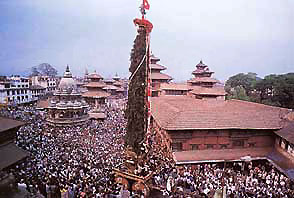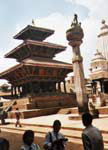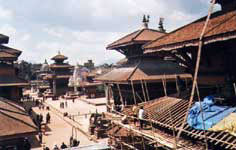|
Patan:
Introduction
|
 |
Some
eight kilometres south of central Kathmandu situated on a plateau across
the Bagmati river is a lovely little city called Lalitpur meaning
the city of fine arts.
 |
| This city also known as Patan-once and independent
Newar - kingdom before the present dynasty took over-is best known
for its finest traditional crafts and rich artistic heritage. This city
of Lalitpur divided into 22 municipal wards and in inhabited by
A by roughly 160.000 people. A substantial portion of its population
is engaged in various trades, specially in traditional handicrafts and
small scale family industries. |
|
Lalitpur
in fact is the only town in all Nepal that has produced the highest
number of most talented artists and finest craftsmen ever recorded
in Nepalese art history. The most famous Newar artists and master craftsman,
like Arniko, Abhay Raj and Siddhi Raj, were all born in Lalitpur.
| It
is said that the city was designed and built after the Buddhist Dharma
Chakra (the wheel of righteousness). It is surrounded by four big stupas
- one at each corner of its cardinal points. These monuments are said to
have been built by the Indian Emperor Ashoka when he came to Kathmandu
Valley on his pilgrimage tour some 2,250 years ago. When we look at the
size and shape of these stupas they in many ways seem to breathe their
antiquity in a real remote past. It is interesting to note that there are
more than 1,200 Buddhist monuments of various shapes and sizes scattered
in and around this city alone. |
 |
However,
the most important monumental centre of this city is of course, Patan
Durbar Square, which to our great delight has been recognized by UNESCO
as a World Heritage Site.
A
British traveller Percival London was highly impressed by the: sight of
this beautiful square wrote way back in 1928 "As an ensemble, the Durbar
in Patan probably remains the most picturesque collection of buildings
that have been set up in so small a place by the piety of oriental man".
In fact Patan Durbar Square is the only monumental area in all three cities
of Kathmandu Valley that still out stands with its most magnificent architectural
splendour and unique artistic beauty. Patan in its long chequered history
has undergone many sociopolitical upheavals. Even so this lovely little
city seems to have fairly well preserved its glorious cultural heritage
and the history of its finest craftsmanship.
 |
| Lalitpur
said to have been founded by King Veer Deva in 299 A.D. has many
old names such as Yala, Yupagram, Lalitpatan, and Maningal. Several
historical records plus many other legends, also indicate that Patan is
the oldest of all three cities of Kathmandu Valley. According to a very
old Kirat chronicle edited by a noted research scholar Prem Bahadur
Subba, Patan was founded by Kirab rulers long before the Lichhavi rulers
came into the political scene in Kathmandu Valley. |
|
According
to him the earliest known capital was most possibly removed from Thankot
to Patan after the Kirab King Yalamber came into power sometime
around second century A.D.
It
must be remembered here that one of the most used and typical Newari name
of Patan is Yala. It is said that King Yalamber named this city after
himself and ever since then this ancient city was known as Yala.
Lalitpur - the city of arts, as the name translates into English - will
have yet more art structures. This time not at the Durbar Square or other
parts of inner Lalitpur city but right at the entrance to the city. Construction
for a welcome gate at Kupondole, just across the Bagmati bridge that separates
Lalitpur from Kathmandu has already started. Besides separating the two
districts, the gate will also depict the rich arts and culture of the Lalitpur
city.
There
are three more concrete structures in the planning in the form of overhead
crossing bridge in between Kupondole and Pulchowk. The beautification scheme
will be complemented by seven traffic islands between the Sukraraj Sastri
statue near engineering campus and Narayani Hotel as soon as the ongoing
road broadening works are completed. This works are a part of Municipality's
plan to make Patan, an ideal city within five years.
The City
of Patan was initially known as Manju Pattan or "city of Manju", named
after Manjushree, who, according to legends, cut open the hill at Chovar
and drained away water from the lake that the Valley was some 2600 years
ago. The name of this oldest city in the Valley was later changed to "Asok
Pattan" after Charu Mati, the daughter of Emperor Ashoka from Baishali
(now in Indian State of Bihar), built four stupas in the name of her father
around the city during 3rd Century BC. Later the name was changed into
"Lalit Pattan" or "city of arts" because of its highly artistic features.
At present the city is known as Patan, resembling its links to "Pattan"
meaning city and the entire district is named as Lalitpur meaning the place
of arts.
On
the welcome bridge miniature Khrishna Mandir and Mahabouddha temple two of the best artistic structures of the city and a miniature Swoyambhu
(as the stupa can be seen from all the four Ashoka stupas around the city)
will be built.
| 







